THE HIDDEN DANGERS OF THE SEA
Luciano Schiazza M.D.
Dermatologist
c/o InMedica - Centro Medico Polispecialistico
Largo XII Ottobre 62
cell 335.655.97.70 - office 010 5701818
www.lucianoschiazza.it
Dedicated to holidays. This is the sense of what you are about to read. In fact it is during holidays that we can come across some dangerous sea species unknown or underestimated by the majority of people. We are in fact talking about the damages to our skin provoked by some particular inhabitants of the sea.
We are going to talk about:
JELLYFISH
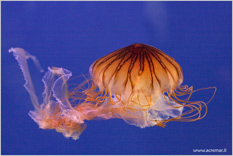
They belong to the coelenterate family, to which also belong actiniae and corals. They have umbrella shape from which come out many tentacles. They are mainly made of water, don’t have muscles and drift on the surface following the current. They normally live alone, but they can be seen in groups.
The danger comes from the tentacles or near to the mouth. Here in fact, there are small organules, called cnidocytes having inside a few urticant vescicles (nematocysts) full of toxins. They are violently expelled (2-5 lb – 0.9/2 kg- per square foot) when the jellyfish is touched: they penetrate the skin and, through a thin filament they release toxic substances
The severeness of the sting changes according to the species, dimension, geographic area and season: in fact the intensity of the pain varies from a more or less intense pain (similar to the one of a scald) to the irritation of the skin, up to an unbearable pain with severe injury of the skin, weakness, nausea, vomit, breathing difficulties, cramps and muscular pain, hypotension.
The skin injuries are often linear as to reproduce the shape of tentacles and they come out after a few minutes or hours, subject to the contact intensity and the quantity of toxins absorbed by the skin.
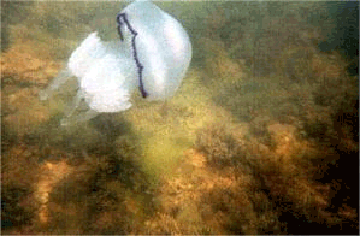
In our seas jellyfish are frequently observed: in Liguria one of the most common jellyfish is Rhizostoma pulmo. It has a milk white-slightly blue color, the umbrella is surrounded by purple edges. The diameter can exceed 50-60 cm, with short and dumpy tentacles. To be absolutely avoided is the Pelagia noctiluga also called “fluorescent” jellyfish, due to its fluorescence that makes it visible at night: small and intensely urticant, it can be often see in extended shoals near to the shore. The diameter of its umbrella is roughly 10 cm, its color purple, pink or brown and the length of its tentacles can reach 40 cm. Cnidocytes are in both: tentacles and umbrella.
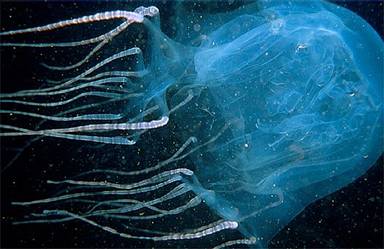
The most dangerous jellyfish cannot be found in the Mediterranean sea, but in Northern Australia: it is the Chironex fleckeri, also called “box or cube jellyfish) for the quadrangular shape, also named by the Philippino and Japanese fishmen “Fire jellysish”. It is small (the diameter measures 5-6 cm) with tentacles extending from a few centimeters to a few meters, transparent.
The extremely painful stings inoculate a neurotoxic poison that can cause death in a short time. It hides in low waters among mangrovia roots, at the river mouths. During the dry season (May/October) it leaves the costal area and moves to the open sea. They are said to make more victims than sharks.
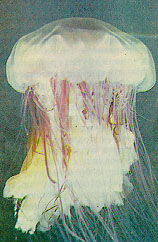
Out of curiosity: the biggest jellyfish lives in the Artic Sea: it is the Cyanea artica, known as Lion’s mane.
Its umbrella has two and a half meters diameter and tentacles reach the length of 40 meters
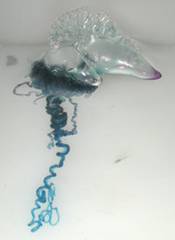
To be mentioned is also the Physalia Phisalis, known as Portuguese Caravel. It lives in Tropical seas. It has a floating upper part similar to an inflated blue plastic bag (which can be confused with water and makes therefore difficult to spot it), with very thin tentacles, translucent, they can reach the length of 40 meters.
Their toxicity can be compared to the one of a cobra snake
First aid
-
First of all check vital functions
-
The victim has to be relaxed, for pain and stress may cause Muscular activity that helps the diffusion of the toxin.
-
Wash the wound with sea water, possibly lukewarm. Never use fresh water or ice, for they may cause the opening of the nematocysts still sitting in the skin.
-
The application of warm sand can be a helpful first aid
-
Vinegar can be used diluted at 50% with lukewarm water and applied as a compress on the affected area for 10- 15 minutes.
-
If there are still a few neomacyst in the skin never use bare hands to take them out. Use tweezers, shaving foam or soap and razor to shave them out. In alternative use sand mixed with sea water, talcum powder or flour and gently shave with a sharp knife: do not rub the skin!
-
Seek medical advice: in fact it would be useful the treatment with a cortison cream to alleviate the skin reaction and pain killers to alleviate the pain.
-
a shower can be taken after treatmen
ACRINIA
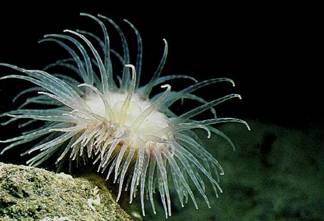
They belong to the coelenterate species as jellyfish and have nematocysts. They look like anemones, this is the reason why they are called “sea anemones”.
They have long tentacles and live in shallow waters close to rocks. In the Mediterranean area sea anemones provoke more damage than other species due to the fact that they can affect large skin areas: e.g. they can sting people sitting on the rocks partially submerged by water.
First aid
Same treatment as for jellyfish.
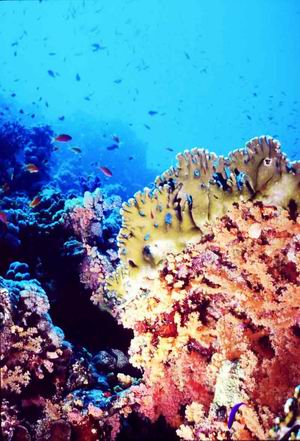
CORALS
The aspect is well known: calcareous rocks with holes from which come out fixed polyps. The risk comes from abrasions and cuts that may occur walking on them or bumping on them while swimming. In fact, the wounds easily suppurate. Attention must be paid while walking on a coral barer, for you can step on sea urchins or stone fish. Pay attention when you pick coral florets that emerge from the sand (bommie): it might be a fire coral (millepora dichotoma). We could get in touch with mollusces (cones in a triangle shape having on its apex a tentacle that gives a paralyzing poison) and with the sea snake.
First aid
-
Clean the wound thoroughly and keep it clean with disinfectanttincture
-
Anti tetanus shot is recommended.
TRACINA
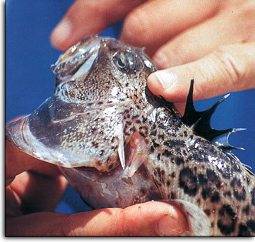
lso known as “spider fish”. It lives in shallow waters or along shores camouflaging itself in the sand, under the sea surface. If you step on it (it is recommended to wear plastic sandals) it will defend itself stinging with its dorsal aculei It is quite easy to be stung. The pain is acute, excruciating. In 30 minutes it might go up the leg up to the inguen. It may last 16-24 hours.
First aid
-
Wash the wound with sea water.
-
Gently remove fragments (if any) of bone avoiding to damage the tissues.
-
To retard the diffusion of poison put a haemostatic string just above the affected area, releasing the tension every 90-120 seconds in order not to stop artery flux.
-
Using a “poison suction pump” (a suction pump that applied on the skin creates a depression), take off as much poison as possible.
-
Soak as soon as possible the foot in sea water or very hot saline solution (the toxin is thermo sensitive) for 60/120 minutes, or till the pain diminishes: this will deactivate the poison.
-
Should hot water not be available you can put the tip of two lighted cigarettes close to the affected area for 5 – 10 minutes.
SEA SCORPION
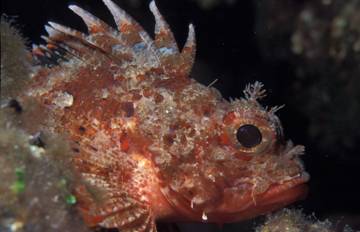
Typical sea bottom fish, it adopts camouflage and can be confused with sand, algae, corals and rocks. It stings when you step on it. The sting of the dorsal rays of the fin gives in a few seconds an excruciating pain that lasts for a few hours.
Sometimes it provokes systemic symptoms such as nausea, vomit, headache, vertigo, hypotension, fainting. Sometimes necrosis may occur in the affected area.
First aid
Same treatment as per the Tracina
STONE FISH
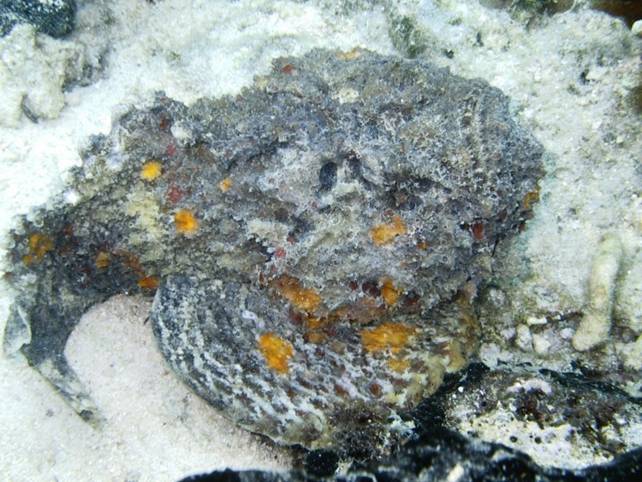
Pay attention to the uncontaminated beaches and when you go to the beach early in the morning. If you are in a holiday village wait till the staff has cleaned the beach and captured this terrible fish. To step on the dorsal bones of the fin would provoke stings, pins and needles, noticeable functional limits and intense discomfort with perspiration, dyspnea and cardiac insufficiency. Same treatment as per Tracina sting. It might be necessary to consult a physician for an anti-shock treatment.
SEA URCHINS

They belong to the echinoderm (echinos = urchin or spiky shape). They are round shaped and are covered with strong calcareous thorns. The endoskeleton is rigid and non flexible. In the Mediterranean there are three major species:
Paracentrous lividus, Arabica lixula, Sphaerechinus granularis. While the Atlantic and Pacific species are moderately toxic (they might provoke nausea, vomit, diahrrea, headake, allergy), (rarely death), the Mediterranean species are less toxic and give immediate and retarded reactions. They live on top of rocks and caves
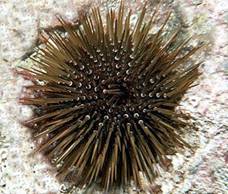
Immediate reactions come from the broken thorns in the skin. Sharp and frail the thorns are difficult to extract. Pain is immediate and can last for a few hours; this is followed by swelling and irritation in the affected area
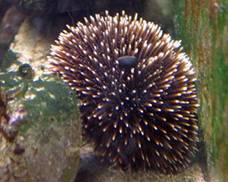
Retarded reactions come after 2 – 3 months and consist of dark red hard nodules (granuloma) in the previously affected area.
Professional fishermen as a consequence of frequent stings by sea urchins may get a hard edema on the back of the hands that may cause difficulty in the movement of the wrist and fingers
First aid
-
To alleviate the pain soak the affected part in hot water (43 -45 C)
-
In order to avoid infections it is important to remove the thorns one by one with sterilized tweezers or a needle. This has to be done gently to avoid the rupture of the thorns in the wound. In alternative you may choose the “kikuyu treatment” that consists of the application of fresh papaya for approx 30 minutes. This to benefit from the cheratolitic action of papaine.
-
Disinfect the wound.
-
In the event that the thorns have profoundly ran in the skin, to avoid infection and abscesses in the small articulation of hands and feet, it might be necessary the surgical remotion of the thorns. This to avoid articular or tendon (tendonitis) complications, for if not well treated might lead to permanent damages.
-
In the case of retarded reactions it is recommended to consult a physician.
-
It is important to be protected by anti tetanus profilax.
